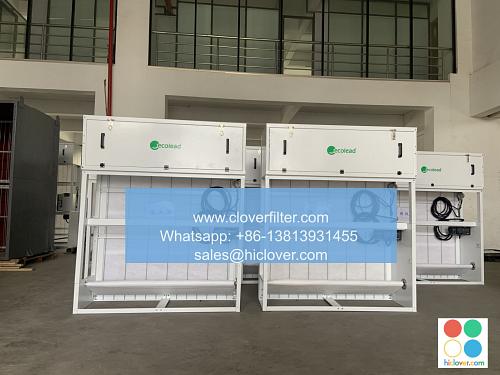Automatic Roll Air Filters: A Key Component of British Columbia Cleanroom Design

British Columbia is known for its lush natural environment and strict regulations to maintain its pristine condition. One of the key sectors that adhere to these regulations is the cleanroom industry, which requires meticulous attention to detail and a commitment to cleanliness. Cleanrooms are controlled environments that minimize airborne particles, making them ideal for manufacturing, research, and development in industries such as pharmaceuticals, biotechnology, and electronics. A crucial component of British Columbia cleanroom design is the automatic roll air filter (ARAF), which plays a vital role in maintaining the required level of air quality.
Automatic roll air filters are designed to provide a continuous supply of filtered air, removing airborne particles and contaminants that could compromise the cleanroom environment. These filters are typically installed in the cleanroom’s ventilation system and are programmed to automatically roll out a new filter media as the old one becomes saturated with particles. This process ensures that the air quality in the cleanroom remains consistent and within the required parameters.
The benefits of using automatic roll air filters in British Columbia cleanrooms are numerous. Firstly, they provide a high level of air quality control, which is essential for industries that require a sterile environment. Secondly, they reduce the risk of contamination, which can be catastrophic in industries such as pharmaceuticals and biotechnology. Thirdly, they minimize the need for manual intervention, which reduces the risk of human error and saves time and resources. Finally, they provide a cost-effective solution for cleanroom air filtration, as they can be programmed to optimize filter usage and reduce waste.
The design and installation of automatic roll air filters in British Columbia cleanrooms require careful consideration of several factors. Firstly, the filter’s airflow rate and efficiency must be compatible with the cleanroom’s ventilation system. Secondly, the filter’s size and configuration must be suitable for the cleanroom’s layout and equipment. Thirdly, the filter’s control system must be programmable and easy to use, to ensure that the filter operates optimally and with minimal manual intervention. Finally, the filter must be designed and constructed to meet the relevant industry standards and regulations, such as those set by the International Organization for Standardization (ISO) and the Institute of Environmental Sciences and Technology (IEST).
In addition to their technical specifications, automatic roll air filters must also be designed with maintenance and upkeep in mind. Regular maintenance is essential to ensure that the filter operates effectively and efficiently, and that the cleanroom environment remains uncontaminated. This includes tasks such as monitoring the filter’s performance, replacing the filter media as needed, and performing routine cleaning and inspections. By incorporating maintenance-friendly design features, such as easy-access panels and minimal wiring, automatic roll air filters can be designed to minimize downtime and reduce maintenance costs.
Conclusion:
In conclusion, automatic roll air filters are a critical component of British Columbia cleanroom design, providing a high level of air quality control, reducing the risk of contamination, and minimizing manual intervention. By carefully considering the design and installation of these filters, cleanroom operators can ensure that their facilities meet the required standards for air quality and contamination control. Whether in the pharmaceutical, biotechnology, or electronics industries, automatic roll air filters play a vital role in maintaining the pristine conditions required for manufacturing, research, and development.
FAQs:
Q: What is the purpose of an automatic roll air filter in a cleanroom?
A: The purpose of an automatic roll air filter is to provide a continuous supply of filtered air, removing airborne particles and contaminants that could compromise the cleanroom environment.
Q: How do automatic roll air filters work?
A: Automatic roll air filters work by automatically rolling out a new filter media as the old one becomes saturated with particles, ensuring that the air quality in the cleanroom remains consistent and within the required parameters.
Q: What are the benefits of using automatic roll air filters in British Columbia cleanrooms?
A: The benefits of using automatic roll air filters in British Columbia cleanrooms include providing a high level of air quality control, reducing the risk of contamination, minimizing manual intervention, and providing a cost-effective solution for cleanroom air filtration.
Q: What factors must be considered when designing and installing automatic roll air filters in British Columbia cleanrooms?
A: The factors that must be considered when designing and installing automatic roll air filters in British Columbia cleanrooms include the filter’s airflow rate and efficiency, size and configuration, control system, and compliance with relevant industry standards and regulations.

